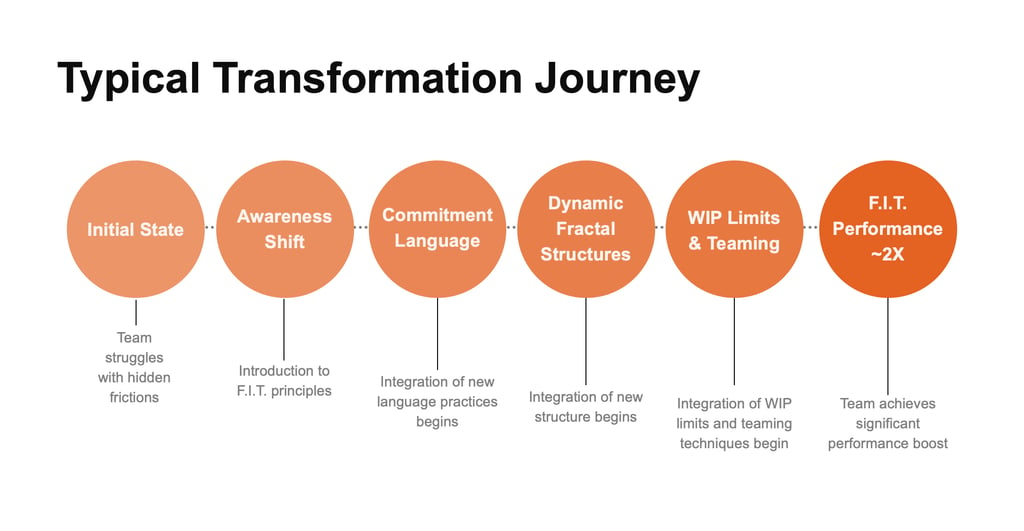Introducing the F.I.T. Formula: Fractals, Flow, and Focus

When Teams Plateau
Many agile teams often get stuck and struggle to achieve high performance. Worse, most 'fixes' are transactional in nature and fail to make a significant difference. Understanding the underlying challenges is key to unlocking their potential and engagement. Stuck teams exhibit:
LOW ENGAGEMENT
Team members show up, but they’re checked out. They attend events, but they don’t actively contribute.
POOR COLLABORATION
Individual silos form, and people retreat into their own work. Stories are handed off between roles.
Tasks remain in progress with no urgency. People wait for someone else to act.
SOCIAL LOAFING
LOW ACCOUNTABILITY
When people aren’t held accountable for their work, commitments become suggestions. Sprint goals are unmet. Deadlines are missed.
LACK OF COLLECTIVE OWNERSHIP
Responsibility for tasks is primarily individual and an “I” mentality is pervasive.
Team members don’t feel trusted to make decisions, slowing progress and stifling innovation.
LOW EMPOWERMENT
A lack of skill-sharing leaves the team vulnerable to bottlenecks when key members are unavailable.
MINIMAL CROSS-TRAINING
Effort is being spent, but outcomes remain minimal, and value isn’t delivered efficiently.
LOW PRODUCTIVITY
All of this adds up to slow delivery, with stories rolling over from sprint to sprint.
CONSISTENT CARRYOVER
The F.I.T. Formula
Get Scrum F.I.T. introduces The F.I.T. (Fractals-in-Teams) Formula and helps teams break through plateaus by restoring flow, rekindling engagement, and transforming daily habits into measurable progress. It's a practical system that helps Scrum teams improve focus, accountability, and delivery through Commitment Language, Dynamic Fractals, WIP Limits, and Teaming Techniques.
Commitment Language
Commitment language is a way to express and clarify daily expectations within a team, fostering accountability and trust among team members. Clear commitments enhance team cohesion and efficiency, as they reduce ambiguity and ensure everyone understands daily tasks and goals.
Dynamic Fractal Structures
Three to four-person dynamic fractal structures focus on a subset of stories, ensuring shared responsibility and partnership. Fractals enable fast decision-making, deeper collaboration, and collective ownership, leading to faster delivery, stronger trust, and a more resilient team.
WIP limits cap active work items in progress, forcing the fractal to focus on finishing before starting new work. WIP limits reduce context switching, lower cognitive load, and unlock flow with higher quality outcomes.
WIP Limits
Teaming Techniques
High-collaboration, real-time teaming techniques accelerate learning, improve quality, and foster shared ownership by making thinking visible and distributing knowledge across the team.
Whether you’re a Scrum Master, Product Owner, Agile Coach, or Agile Leader, The F.I.T. Formula gives you the structure and language to turn teamwork into consistent performance.
Why It Works
The F.I.T. Formula works because it aligns team behavior with the underlying principles of cognitive science, systems thinking, and behavioral psychology—all proven to drive sustained performance in complex environments.
David Marquet – Leadership is Language & Turn the Ship Around
Charles Duhigg – Smarter Faster Better & The Power of Habit
James Clear – Atomic Habits
Daniel Coyle – The Culture Code
Peter Senge – The Fifth Discipline
Donella Meadows – Thinking in Systems
Robert Putnam – Bowling Alone
John Sweller – Cognitive Load Theory
Mihaly Csikszentmihalyi – Flow
Donald Reinertsen – The Principles of Product Development Flow
Elinor Ostrom – Governing the Commons
David J. Anderson – Kanban
Amy Edmondson – Teaming & The Fearless Organization
Anita Woolley – Collective Intelligence Research
Patrick Lencioni – The Five Dysfunctions of a Team
Richard Hackman – Leading Teams: Setting the Stage for Great Performances
The F.I.T. Formula's Underlying Research


Wait! Scrum Says “No Sub-Teams.”
And that’s exactly right. The Scrum Guide states that within a Scrum Team, there are no sub-teams or hierarchies—a safeguard against silos and divided accountability. Get Scrum F.I.T. aligns fully with this principle. Dynamic Fractals act as execution patterns, not structural splits. They are short-lived, self-organizing configurations that stay together for a Sprint and reform as priorities evolve, always serving one Product Goal and one Sprint Goal. This keeps collaboration fluid while maintaining a single backlog, cadence, and Definition of Done. Fractals make self-organization visible and disciplined, strengthening the unity that Scrum intends: one cohesive team, dynamically adapting without losing shared ownership. Think of the Scrum Team as a living system, and The F.I.T. Formula as its adaptive response mechanism.
The Journey
Get Scrum F.I.T. follows Alex, a newly promoted Scrum Master tasked with transforming a dysfunctional team into a high-performing unit under tight deadlines. Tess, a brilliant but skeptical developer, often challenges the team’s direction, while Ravi, the meticulous QA lead, pushes for precision at every step. Kira, the strategic Product Owner, balances stakeholder expectations with team dynamics. Eli, the seasoned Agile Coach, serves as Alex’s mentor, introducing the F.I.T. Formula and guiding the team through its transformation. Together, this diverse group navigates conflict, growth, and collaboration to achieve remarkable results and redefine what it means to succeed as a team.
Available in paperback
Buy on Amazon →
About the Author
Dr. Anthony W. Montgomery is a Board Certified Coach, an Enterprise Agile Coach, leadership consultant, and former military officer whose work bridges systems thinking, behavioral science, and organizational transformation. Drawing from years of leading teams in complex environments, he created The F.I.T. Formula to help Scrum teams move from transactional fixes to systemic transformational growth. Anthony’s research-based approach blends the principles of flow, accountability, and psychological safety with practical coaching methods that have reshaped teams across healthcare, technology, and financial services. His writing and workshops challenge teams to think differently—focusing less on process compliance and more on shared ownership, micro-habits, and human systems that finish what they start.
For consulting, coaching, or training inquiries, email contact@getscrumfit.com
© 2025. All rights reserved.